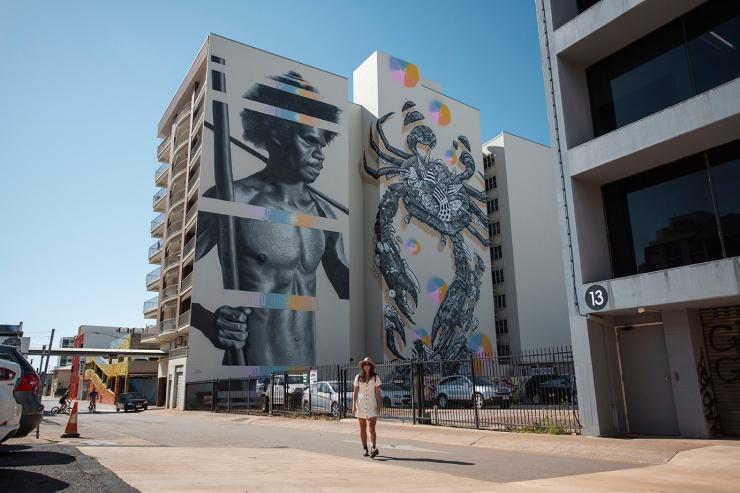
Birrunga Gallery & Dining, Brisbane, Queensland © Tourism and Events Queensland
Ethically Buying Aboriginal and Torres Strait Islander Art
Australia is home to some of the oldest and most incredible artworks in the world: Aboriginal and Torres Strait Islander art.
By Paul McBride of Gilimbaa
Aboriginal and Torres Strait Islander artworks are unique forms of cultural expression centred on storytelling. They are deeply connected to millennia of lore, language, culture and Country. As well as being highly sought after for their artistic beauty, they offer a meaningful insight into the strength, diversity and richness of Aboriginal and Torres Strait Islander (also known as First Nations) peoples, cultures, and histories.
The recent boom in popularity of cultural art is worth a significant amount of money to artists, their families and communities, so it’s vital that steps are taken to ensure any First Nations artwork you buy was sourced ethically, to maintain an honest and equitable income for artists and their families. There are so many reasons why an Aboriginal and Torres Strait Islander artwork should be the ultimate souvenir of your visit to Australia, but what should you look for or ask when purchasing First Nations art?
1. Ensure the artwork has been created by a First Nations person

Ernabella Art, Longitude 131, Uluru, Northern Territory © Longitude 131
Sometimes artists, often overseas, are paid small amounts to produce cheap copies of artworks, which are then passed off as authentic and sold to unknowing buyers. When purchasing First Nations artwork, you are within your rights to ask who the artist is and where they are from – an ethical vendor will always be able to supply this information.
Authentic products will often have supporting documentation, such as a certificate or statement of authenticity, which should contain the artist’s name, biography, community, and sometimes a photograph. Artworks sold in art centres or galleries may also have a catalogue number.
Remember that First Nations art doesn’t just appear on canvas but can be found on items from t-shirts and fridge magnets to beach towels, so ask yourself where that artwork has come from and who is profiting from its sale.
2. Source artwork directly from the artist whenever possible

Tiwi Island Grand Final and Art sale, Tiwi Islands, Northern Territory © Peter Eve/Tourism NT
Exploitation of artists can occur when artworks are bought at low prices and sold for big profits; this often takes place when unscrupulous vendors take advantage of artists who might not know their rights or the true value of their work.
An increasing number of Aboriginal and Torres Strait Islander artists are using their own websites and social media to sell directly to buyers worldwide, reducing the chance of unethical behaviour by third-party vendors. It also presents the opportunity to ask questions about the artwork’s meaning, and the artist’s Country, culture, and community. Artists selling artworks online will be happy to answer questions about their artworks and by buying their work directly from them, you can more effectively support their business and career. You can also help raise their profile by sharing their story and that of the artwork among your friends and family, and on social media.
Aboriginal and Torres Strait Islander-owned art centres and enterprises are a great option to check out, as they are a conduit between artists and market, and allow artists to have a sustainable income while living on Country and sharing their stories with the world.
3. Ask the vendor about how the artist is paid

Narana Aboriginal Cultural Centre art gallery, Geelong, Victoria © Robert Blackburn
As a buyer of Aboriginal and Torres Strait Islander art, you are fully entitled to know how the artist is paid, so don’t hesitate to ask. Most vendors have high ethical standards and a genuine sense of responsibility to artists and their communities and will offer this information upfront in their galleries or on their websites.
The dealer or gallery/art centre owner should be prepared to answer questions about how the artist is paid. The majority of the sale price should go to the artist, so ask questions until you are satisfied they are being compensated fairly. This can include asking about the amount or percentage of the retail price the artist receives and, if this is a reproduction of an artist’s work, whether royalties or licensing fees are paid to the artist.
4. Ask the vendor if they are a member of the Indigenous Art Code

Japingka Gallery, Fremantle, Western Australia © Japingka Gallery
The Indigenous Art Code was set up in 2009 to counter exploitation of First Nations artists, with the aim of establishing standards for the business relationships between dealers and artists. The Code ensures fair and ethical trade, transparency in the promotion and sale of artwork, and the efficient and fair resolution of disputes. Signing up to the principles of the Code is voluntary, and ethical vendors should have no issue with operating by its standards, so don’t be afraid to ask if they do.
Following these simple rules will mean you can enjoy your unique souvenir of Australia, safe in the knowledge that you are doing your bit to protect the oldest continuing cultures on earth.



































































































































